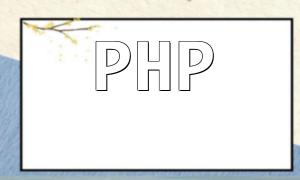When developing web applications with PHP, forms are essential for collecting user input. To prevent malicious data from compromising system stability and security, first ensure that PHP's filter functionality is enabled. Locate the relevant extension settings in the php.ini file, make sure the filters are activated, save the changes, and restart the server to apply.
When building forms, properly configure input fields and their attributes. The following example demonstrates a registration form with username, password, and email fields:
<form action="register.php" method="post">
<label for="username">Username:</label>
<input type="text" name="username" id="username">
<label for="password">Password:</label>
<input type="password" name="password" id="password">
<label for="email">Email:</label>
<input type="email" name="email" id="email">
<input type="submit" value="Register">
</form>After the form is submitted, use PHP's built-in filter functions to sanitize user input:
$username = filter_input(INPUT_POST, 'username', FILTER_SANITIZE_STRING); $password = filter_input(INPUT_POST, 'password', FILTER_SANITIZE_STRING); $email = filter_input(INPUT_POST, 'email', FILTER_SANITIZE_EMAIL);
To further enhance security, validate input formats using regular expressions, for example, allowing only 3 to 20 characters of letters, numbers, and underscores for usernames:
$usernameRegex = '/^[a-zA-Z0-9_]{3,20}$/';
if (!preg_match($usernameRegex, $username)) {
echo "Username must be 3 to 20 characters long and contain only letters, numbers, or underscores.";
exit();
}Similarly, you can define custom validation rules for other fields as needed.
Before storing data in the database, ensure input is properly escaped to prevent SQL injection, for example:
$username = mysqli_real_escape_string($dbConnection, $username); $password = mysqli_real_escape_string($dbConnection, $password); $email = mysqli_real_escape_string($dbConnection, $email);
During validation, issues such as username duplication or weak passwords might occur. Maintain an array to collect error messages for unified display:
$errors = array();
// Check if username already exists
if (usernameExists($username)) {
$errors['username'] = "Username is already taken.";
}
// Check password strength
if (isWeakPassword($password)) {
$errors['password'] = "Password is too weak.";
}
// Display errors
if (!empty($errors)) {
foreach ($errors as $error) {
echo $error . "<br>";
}
}Here, usernameExists() and isWeakPassword() are custom functions you can implement based on your business logic.
By properly using PHP filters, regular expressions, and error collection mechanisms, you can significantly improve form validation security and reduce potential risks. Combined with database escaping and prepared statements, your application can be better protected against common attacks. Remember, while client-side validation improves user experience, server-side validation is critical for data security.
Hope this guide helps you understand and implement secure PHP form validation, empowering you to build safer and more reliable web applications.









